Gas Chromatography with Soft Ionization Mass Spectrometry for the Characterization of Natural Products
Special Issues
Soft ionization MS using GC–APCI-MS and GC–SMB-MS offers complementary identification power for the characterization of natural products, as illustrated by the identification of alkanes, sterols, long chain alcohols, and derivatized polar compounds in tobacco leaf extracts described here.
The application of gas chromatography (GC) combined with atmospheric pressure chemical ionization mass spectrometry (GC–APCI-MS) and with supersonic molecular beam ionization mass spectrometry (GC–SMB-MS) is described in this article. These ionization modes offer complementary information that helps to unravel the complexity of extracts from natural products. They are also compatible with high-temperature GC, which extends the GC application range to higher-molecular-weight apolar solutes. Additionally, soft ionization can be very useful for the characterization of polar fractions analyzed by GC after derivatization (silylation). Derivatized sugars, organic acids, and amino acids show strong fragmentation in electron ionization–mass spectrometry (EI–MS) with non-characteristic fragment ions, whereas GC–APCI-MS and GC–SMB-MS offer easier feature extraction and compound identification.
Natural products contain a broad range of organic molecules, including low- to high-molecular-weight compounds and apolar to polar solutes. Several analytical methods are therefore required to unravel the complexity, characterize the product, and identify important constituents of natural products. In a very schematic way, natural product constituents can be divided into four classes based on their molecular weight and polarity (Figure 1). Classical gas chromatography–mass spectrometry (GC–MS) with electron ionization (EI) is typically applied for the analysis of low-molecular-weight, apolar (and thus relatively volatile) solutes, resulting in high sensitivity and library searchable spectra. For apolar high boiling solutes, such as lipids, high-temperature GC or liquid chromatography (LC) are used. Polar constituents, such as sugars and amino acids can also be analyzed using LC or GC but require derivatization. Finally, the polar high-molecular-weight constituents such as proteins and oligosaccharides are typically analyzed by LC (including size exclusion chromatography [SEC]) or by electrophoretic techniques.
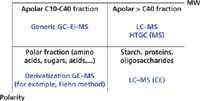
Figure 1: Schematic overview of the four classes of natural product constituents.
The borders between the four quadrants in Figure 1 should not be considered as "solid," but rather as "transition zones." Since GC is characterized by high resolving power, research in GC–MS is continuously exploring ways to extend the applicability from the low-molecular-weight apolar zone — the "classical" GC–MS application area — into the higher molecular weight zone and the more polar fraction. Three main obstacles are encountered:
Firstly, in the apolar fraction, compounds such as waxes and alcohols show strong fragmentation, and no molecular ion is detected in GC–EI-MS making unequivocal identification difficult. Secondly, for the elution of high-molecular-weight compounds, high-temperature GC conditions, such as the selection of a column with a high phase ratio (wide bore + thin film), high column flows (> 5 mL/min), and very high temperatures, are needed. These conditions are not compatible with classical benchtop MS systems. Finally, the polar fraction of natural products is important. While this fraction can be analyzed by GC after derivatization (for example, using the metabolomic method developed by Fiehn [1,2], involving oximation and silylation), identification of derivatized sugars, organic acids, and amino acids is difficult because of strong fragmentation in electron ionization.
For these reasons, soft ionization techniques combined with MS can offer complementary information. The best known are (positive ion or negative ion) chemical ionization (3) and, more recently, single photon ionization (4). In this article two other alternatives for GC soft ionization MS were evaluated: GC hyphenated to atmospheric pressure chemical ionization (APCI) on a high resolution time-of-flight (TOF) MS system (5) and GC combined via a supersonic molecular beam (SMB) interface and a single-quadrupole MS system (GC–SMB-MS) (6). These ionization modes are also compatible with higher capillary column flows that are often used in high temperature GC, and are therefore quite interesting to extend the range of "GC-amenable" solutes to higher-molecular-weight solutes, such as long chain alcohols and lipids. The aim of this article was not to provide a detailed technical description of these ionization modes, but rather to illustrate their application in natural product research. Both hyphenated methods were evaluated using tobacco leaf extracts (both apolar and polar extracts) as an example, but the GC–APCI–TOF-MS and GC–SMB–MS methodology can be extended to a wide range of applications in natural products, including tea, herbal medicines, plant extracts for cosmetics, and more.
Experimental
Sample Preparation
Two types of extracts were prepared from tobacco leaves. The apolar fraction was extracted using hexane (1 g of leaves in 10 mL of hexane) and ultrasonic agitation. This extract was analyzed after filtration.
The polar extract was prepared in a 3:1:1 mixture of water–methanol–acetonitrile (7). Then 1 g of sample was extracted in 10 mL of extraction solvent. Following this, 50 μL of extract was dried under nitrogen and derivatized by oximation (100 μL of freshly prepared methoxylamine in pyridine, 20 mg/mL, 90 min at 30 °C) followed by silylation (100 μL of MSTFA, 60 min at 37 °C) (2).
Instrumentation
GC–APCI–TOF analyses were performed on an Agilent 7890A GC system coupled to an Agilent 6230 TOF-MS system using a G3212A GC-APCI interface (5). GC instrument control and data handling were carried out using the Mass Hunter Workstation Software (Agilent Technologies). This software contains several features for deconvolution (EI spectra), molecular feature extraction (APCI spectra), peak finding and identification. A standard Agilent 5975 MSD mass selective detection system was coupled to the left side of the GC system, while the 6230 TOF instrument is coupled to the right. The analysis of apolar semi-volatile solutes was performed with both MS systems operated in parallel using column effluent splitting (1:1) via a capillary flow two-way splitter. The interface bundle consists of a heated transfer line that fits into the APCI source. In comparison to a standard orthogonal spray LC–APCI source, the corona needle is repositioned on top of the APCI source, orthogonal to the GC column outlet (with the needle very close to the end of the capillary GC column). The GC column can either be coupled directly to the APCI source or via a tee-piece, allowing the introduction of make-up flow, coaxial with the capillary column (5).
GC–SMB–MS was performed using an Agilent 7890A GC system coupled to an Agilent 5975 MSD system using a supersonic molecular beam (SMB) interface (AVIV Analytical). The SMB interface consists of a supersonic jet interface, skimmer, and fly-through ion source (replacing the standard 5975 MSD EI source) (6). Instrument control and data collection were carried out using MSD ChemStation (Agilent Technologies) and SMB control software (Aviv Analytical). The Tal-Aviv Molecule Identifier software (Aviv Analytical) (Version 3.3a) was used for formula generation.
Analytical Conditions
The analysis of volatiles and semivolatiles of the apolar extracts was performed on a 30 m × 250 μm, 0.25-μm df HP-5MS column film (Agilent Technologies), using splitless injection at 280 °C. The flow rate was constant at 1.2 mL/min helium, and the oven temperature program was 50 °C (1 min), 10 °C/min, and then 320 °C. The MS scan range was from 40–500 amu. On the GC–APCI-TOF instrument, the GC column effluent was split using a capillary flow device splitter in a 1:1 ratio between a single-quadrupole MSD system and the APCI-TOF system. For GC–SMB-MSD, helium make-up gas (77 mL/min at 920 mbar) and a programmed transfer line temperature from 280 °C(10 min), 10 °C/min and then held at 320 °C were used.
For high temperature GC–MS analysis of the apolar fraction, the conditions for GC–APCI-TOF and GC–SMB-MSD analyses were as follows. The column was an 15 m × 530 μm, 0.15-μm df HP-SIMDIST column (Agilent Technologies). A 1-μL cool on-column (GC–APCI-MS) or PTV injection (GC–SMB-MSD) was performed. Carrier gas was helium operated in constant flow mode at 10 mL/min. The oven temperature program was 40 °C (1 min), 10 °C/min, and then 350 °C (8 min). The MS scan range was 40–800 amu.
For the analysis of the (derivatized) polar extracts by GC–APCI-TOF and GC–SMB-MS, the column was a 30 m × 250 μm, 0.25-μm df HP-5MS column (Agilent Technologies). A 1-μL split injection (1:10 split ratio) was performed at 250 °C. Carrier gas was helium at 1.2 mL/min constant flow. The oven temperature program was 60 °C (1 min), 10 °C/min to 325 °C. The MS scan range was from 40–800 amu. For GC–SMB-MSD, helium make-up gas (77 mL/min at 920 mbar) and a programmed transfer line temperature from 280 °C (10 min), 10 °C/min, and then held at 325 °C were used.
Results and Discussion
When an apolar extract of tobacco leaves is analyzed using a "generic" GC–MS method on a single-quadrupole low-resolution instrument with EI, a detailed profile of volatile to semivolatile organic compounds is obtained. With split–splitless injection, a standard 30 m × 0.25 mm, 0.25-μm df HP-5MS column programmed from 50 °C to 320 °C and when applying a 1.2 mL/min flow rate, solutes with linear retention indices between 500 and 3500 can be analyzed. In the profile of tobacco leaves, alkaloids (nicotine), fatty acids, waxes and sterols, are detected, as illustrated in Figure 2a.
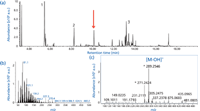
Figure 2: Parallel GCâEI-MSD and GCâAPCI-TOF-MS analysis of the apolar semivolatile fraction of tobacco leaf. The column effluent was split 1:1 using a capillary flow splitter between the MSD system and the APCI-TOF system. (a) Total ion chromatogram (GCâEI-MSD) - peaks: 1 = nicotine, 2 = phytol, 3 = sterols and waxes; (b) EI mass spectrum (GCâMSD) of 4,8,13-duvatriene-1,3-diol; (c) APCI mass spectrum (GCâAPCI-TOF-MS) of 4,8,13-duvatriene-1,3-diol.
During this analysis, it was not possible to fully identify all important constituents. In particular some alcohols, waxes (alkanes), and sterols are more difficult to differentiate because EI results in strong fragmentation and little information on molecular ion (and thus molecular weight) is obtained. For that reason, the combination of GC with APCI-MS was tested. This was done using a GC system coupled via a dedicated GC–APCI interface to a high-resolution TOF instrument. In parallel, a standard MSD system with EI was installed on the right side of the GC system. Using column effluent splitting, simultaneous GC–EI-MSD and GC–APCI-TOF-MS data could be acquired. With APCI-TOF-MS, a softer ionization is obtained and, in conjunction with high resolution, accurate mass detection. Experiments with different classes of solutes have demonstrated that medium to high sensitivity is obtained, depending on make-up gas type (added coaxial with column) and APCI source chemistries and solute type.
An example of parallel GC–EI-MSD and GC–APCI-TOF analysis and identification is illustrated for the apolar extract of tobacco leaves (Figure 2). In the chromatogram, nicotine (peak 1), phytol (peak 2), and the sterol–wax fraction (peak 3) can easily be detected. The EI spectrum of the peak eluted at 10.2 min (arrow) showed strong fragmentation (Figure 2b), while a clear [M–OH]+ ion was detected in the APCI spectrum (Figure 2c). Based on this information, the compound was identified as 4,8,13-duvatriene-1,3-diol (C20H34O2, molecular weight = 306). The combination of both spectra is quite powerful for identification. Data analysis of the high-resolution TOF instrument was performed. Molecular feature extraction was performed on the sterol fraction of a tobacco leaf extract; several sterols were detected and identified. In addition, [M–OH]+ ions were detected as the most abundant ions.
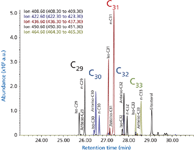
Figure 3: Overlay of extracted ion chromatograms (at molecular ion) of the GCâSMB-MSD analysis of the apolar semivolatile fraction of tobacco leaf. C29âC33 n-alkanes are indicated together with iso- and anteiso-isomers.
A second alternative for soft ionization is the use of a supersonic molecular beam interface, consisting of a jet interface and a fly-through ionization source. The ionization is defined as cold EI since the molecules are entering the source at very low temperatures, which allows for ionization that is much softer. Mass analysis and detection were performed by a single-quadrupole MS system, but the SMB interface can eventually be coupled to other MS devices. When this was applied to the analysis of apolar tobacco leaf extracts, we observed that the total ion chromatogram profiles of classical EI and SMB with cold EI are very comparable, and for certain compounds such as phytol equivalent spectra are also obtained, meaning that the spectra are still searchable in an EI-MS database (such as the National Institute of Standards [NIST]). Compared to classical EI, the higher mass ions are more abundant. Therefore, cold EI proved to be very useful for the characterization of apolar solutes such as alkanes, waxes, and lipids. This is illustrated by the analysis of the alkane fraction in tobacco leaf extract. In contrast to classical EI, the mass spectra of alkanes gave a predominantly molecular ion, and by using the extracted ion chromatograms at the molecular ion, C29 to C33 alkanes could easily be detected (Figure 3). It is clear that in tobacco leaf, a quite unique profile is obtained for odd and even carbon number alkanes. Additionally, branched iso- and anteiso-alkanes can also easily be detected and identified. The mass spectra of the branched alkanes show different high mass fragmentation, allowing for differentiation of iso- and anteiso-methyl substitution.
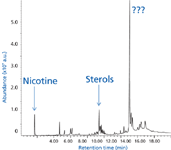
Figure 4: High-temperature GCâSMB analysis of an apolar tobacco leaf extract.
Both GC–APCI-TOF-MS and GC–SMB-MS allow the use of higher column flows (> 5 mL/min), and are very useful for hyphenation with high temperature GC. The analysis of an apolar extract of tobacco leaf was analyzed using a simulated distillation column, temperature programming to 350 °C, and a 10 mL/min column flow. Under "generic" GC conditions, the elution of apolar solutes "ends" after the sterol fraction, but with high temperature GC additional compounds are detected that are eluted well after the sterol–wax fraction (Figure 4). Under these high-temperature GC conditions, a very large peak was detected at 15 min, and this compound could be identified as solanesol (C45H74O, molecular weight = 630). In the cold EI spectrum the molecular ion could clearly be detected (Figure 5a). Using the molecule identifier software, formula generation can be performed on SMB EI spectra acquired on the single-quadrupole MS system. The isotope ratio of the molecular ion is used to calculate possible molecular formulas. Because of the 0.1 amu mass accuracy of the MSD, an additional mass accuracy filter can be applied that reduces the number of possible hits. For solanesol, the correct molecular formula was predicted by using the mass accuracy filter at ± 0.14 Da and the best matching isotope ratios.

Figure 5: Spectra obtained for solanesol by high-temperature GCâMS analysis; (a): cold-EI (GCâSMB-MSD); (b): APCI spectrum.
The high-molecular-weight fraction of the apolar tobacco leaf extract was also analyzed by GC–APCI-TOF-MS. The spectrum of solanesol under GC–APCI conditions is shown in Figure 5b and in this case a clear [M–OH]+ is detected. The presence of an [M–H2O]+ adduct indicates that APCI source chemistry is more complex, but the high mass accuracy is very useful in identification. Typical mass accuracy is better than 5 ppm. Of course, the hyphenation of GC–APCI-MS could also be performed using a quadrupole-TOF instrument, with additional MS–MS capabilities for identification of true unknowns (5).
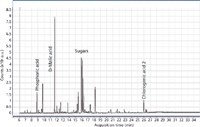
Figure 6: GCâAPCI-TOF TIC chromatogram for the analysis of a derivatized polar tobacco leaf extract.
Both GC–SMB-MS and GC–APCI-MS were also evaluated for the characterization of the polar fraction from tobacco leaves. A profile obtained on the GC–APCI-TOF-MS system clearly shows the presence of acids and sugars as silyl derivatives (Figure 6). Often the interpretation of the mass spectra of silylated (or oximated and silylated) solutes is quite difficult. The classical EI mass spectrum of silylated D-malic acid shows the highest mass ion at [M–CH3]+. Likewise, the mass spectrum obtained by cold EI also shows an [M–CH3]+ ion as the highest mass (Figure 7). However, by using GC–APCI-TOF, a clear [M+H]+ ion was detected in the mass spectrum of this di-TMS derivative (Figure 8). In combination with accurate mass detection (and formula generation software), correct identification was possible.
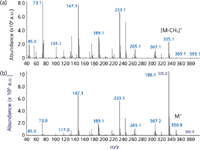
Figure 7: Spectra of D-malic acid from the analysis of a derivatized polar leaf extract by (a) GCâEI-MS and (b) GCâSMB-cold-EI-MS.
Finally, a comparison was made between classical GC–EI-MSD, GC–SMB-MSD, and GC–APCI-TOF-MS for the classification of tobacco leaf types using a metabolomic approach. Apolar extracts from three different tobacco leaf types were analyzed on the three systems and data were deconvoluted and processed using software that allows feature extraction, filtering, and statistical treatment of MS data. For GC–MS, 189 "entities" (solutes) were detected, and after filtering (removing entities that are not detected in all samples), 66 entities remained. For the GC–SMB-MSD data, the number of entities were 975 and 115 before and after filtering respectively. For GC–APCI-TOF-MS, 2496 and 408 entities were detected before and after filtering. This increased number was mainly because of the accurate mass detection.

Figure 8: Spectrum of D-malic acid from the GCâAPCI-TOF-MS analysis.
Conclusions
Soft ionization MS using GC–APCI-MS and GC–SMB-MS offer complementary identification power for the characterization of natural products, as illustrated by the identification of alkanes, sterols, long chain alcohols, and derivatized polar compounds in tobacco leaf extracts. Because of their compatibility with higher column flows, both ionization techniques also offer interesting possibilities for extending GC applicability toward the analysis of high-molecular-weight compounds using high-temperature GC.
GC–SMB-MSD was especially useful for the most apolar solutes, such as alkanes, offering high sensitivity, molecular ion information, and formula generation can be possible.
Ionization in GC–APCI depends on solute type and source conditions, but is very helpful for identification of different classes of natural products and for derivatized solutes. The GC–APCI-TOF-MS approach provides high sensitivity, accurate mass detection, and molecular formula generation. Moreover, the system can be equipped with parallel GC–EI-MS detection and the TOF-MS instrument can be converted in a few minutes into an LC–TOF-MS configuration. These techniques could be useful in natural product research, particularly in the growing field of characterizing traditional Chinese medicines, where true "unknown" analyses are required, but also in other application areas, including lipidomics, metabolomics, and petrochemical analysis.
References
(1) T. Kind, G. Wohlgemuth, D.Y. Lee, Y. Lu, M. Palazoglu, S. Shahbaz, and O.Fiehn, Anal. Chem. 81(24), 10038–10048 (2009).
(2) Q. Gu, F. David, F. Lynen, K. Rumpel, J. Dugardeyn, D. Van Der Straeten, G. Xu, and P. Sandra, J. Chromatogr. A 1218(21), 3247–3254 (2011).
(3) J.T. Watson and O.D. Sparkman, Introduction to Mass Spectrometry, Instrumentation, Applications and Strategies for Data Interpretation, (John Wiley & Sons, 4th Edition, 2007).
(4) W. Welthagen, S. Mitschke, F. Mühlberger, and R. Zimmermann, J. Chromatogr. 1150(1–2), 54–61 (2007).
(5) Agilent Technologies Technical Overview, publication number 5990-7544EN, March 2011 (http://www.chem.agilent.com/Library/technicaloverviews/Public/5990-7544en_lo%20CMS.pdf).
(6) A. Amirav, A. Gordin, M. Poliak, and A.B. Fialkov, J. Mass Spectrom. 43(1–2), 141–163 (2008). For more information: http://www.avivanalytical.com/.
(7) Y. Li, T. Pang, Y. Li, X. Wang, Q. Li, X. Lu, and G. Xu, J. Sep. Sci. 34(12), 1477–1454 (2011).
Frank David is R&D manager at the Research Institute for Chromatography (RIC) and visiting professor at Ghent University, Ghent, Belgium.
Melissa Dunkle is a gas phase specialist at RIC, Belgium.
Bart Tienpont is a gas phase specialist and GC product manager at RIC, Belgium.
Kazuhisa Mitsui is a research scientist at Tobacco Science Research Center, Japan Tobacco Inc., Japan.
Nobukazu Higashi is vice president of Tobacco Business Planning Division, Japan Tobacco Inc., Japan.
Nobuo Ochiai is technical director at GERSTEL K.K., Japan.
Kikuo Sasamoto is technical support manager at GERSTEL K.K., Japan.
Pat Sandra is director of RIC and professor emeritus at Ghent University, Ghent, Belgium.
Direct correspondence to: frank.david@richrom.com
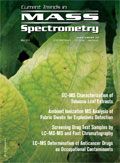
Regulatory Deadlines and Supply Chain Challenges Take Center Stage in Nitrosamine Discussion
April 10th 2025During an LCGC International peer exchange, Aloka Srinivasan, Mayank Bhanti, and Amber Burch discussed the regulatory deadlines and supply chain challenges that come with nitrosamine analysis.









